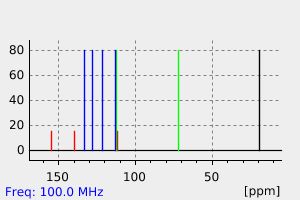1-bromo-2-((2-methylallyl)oxy)benzene | 10178-53-7
中文名称
——
中文别名
——
英文名称
1-bromo-2-((2-methylallyl)oxy)benzene
英文别名
1-Bromo-2-[(2-methylprop-2-en-1-yl)oxy]benzene;1-bromo-2-(2-methylprop-2-enoxy)benzene
CAS
10178-53-7
化学式
C10H11BrO
mdl
MFCD09944339
分子量
227.101
InChiKey
HPZXEWQLFFUHHD-UHFFFAOYSA-N
BEILSTEIN
——
EINECS
——
-
物化性质
-
计算性质
-
ADMET
-
安全信息
-
SDS
-
制备方法与用途
-
上下游信息
-
文献信息
-
表征谱图
-
同类化合物
-
相关功能分类
-
相关结构分类
计算性质
-
辛醇/水分配系数(LogP):3.7
-
重原子数:12
-
可旋转键数:3
-
环数:1.0
-
sp3杂化的碳原子比例:0.2
-
拓扑面积:9.2
-
氢给体数:0
-
氢受体数:1
上下游信息
-
下游产品
中文名称 英文名称 CAS号 化学式 分子量 甲烯丙基苯醚 methylallyl phenyl ether 5820-22-4 C10H12O 148.205
反应信息
-
作为反应物:描述:1-bromo-2-((2-methylallyl)oxy)benzene 在 碘 、 sodium iodide 作用下, 以 N,N-二甲基甲酰胺 、 乙腈 为溶剂, 反应 40.0h, 生成 3-(cyanomethyl)-3-methyl-2,3-dihydrobenzofuran参考文献:名称:光诱导的碳碘化:一种合成功能化的二氢苯并呋喃和二氢吲哚的简单方法摘要:在此,我们报告了在非常温和的条件下发生的简单的氧化还原中性和pH中性光诱导的碳碘化反应。该方案采用容易获得且便宜的芳基溴化物和碘化钠作为起始原料,以良好的产率和优异的产率以及广泛的官能团相容性来合成有价值的官能化二氢苯并呋喃和二氢吲哚。作为证明该方案实用性的实例,完成了克级反应和产物的进一步转化,以合成生物活性药物候选物。最重要的是,据我们所知,该反应是级联原子-自由基转移加成反应的第一个例子,涉及芳族C-Br键的裂解。DOI:10.1002/chem.201603608
-
作为产物:描述:2-溴苯酚 、 3-氯-2-甲基丙烯 在 sodium hydride 作用下, 以 N,N-二甲基甲酰胺 为溶剂, 以92%的产率得到1-bromo-2-((2-methylallyl)oxy)benzene参考文献:名称:钯催化的邻碘苯酚衍生的烯丙基醚与邻硝基苯甲醛的还原氨基羰基化反应生成 3-Alkenylquinolin-2(1H)-ones摘要:已经探索了一种有吸引力的钯催化的烯丙基醚的还原氨基羰基化反应,用于合成 3-alkenylquinolin-2(1 H )-one 衍生物。以Mo(CO) 6作为CO 替代物和还原剂,以邻硝基苯甲醛为氮源,由邻碘苯酚衍生的烯丙基醚以良好至优异的收率获得了多种3-alkenylquinolin-2(1 H )-one . 该反应通过级联途径进行,不依赖于以前的烯丙基羰基化反应所需的高压 CO 气体。该策略为构建 3-alkenylquinolin-2(1 H )-ones 提供了新途径。DOI:10.1021/acs.orglett.2c00648
文献信息
-
Pd-Catalyzed Highly Regio- and Stereoselective Formation of C–C Double Bonds: An Efficient Method for the Synthesis of Benzofuran-, Dihydrobenzofuran-, and Indoline-Containing Alkenes作者:Yang Gao、Wenfang Xiong、Huoji Chen、Wanqing Wu、Jianwen Peng、Yinglan Gao、Huanfeng JiangDOI:10.1021/acs.joc.5b01024日期:2015.8.7A highly regio- and stereoselective C–C double bond formation reaction via Pd-catalyzed Heck-type cascade process with N-tosylhydrazones has been developed. Various N-tosylhydrazones derived from both ketones and aldehydes are found to be efficient substrates to provide di- and trisubstituted olefins with high regio- and stereoselectivity. Furthermore, this reaction has a good functional group tolerance
-
DNA-PK INHIBITORS申请人:Vertex Pharmaceuticals Incorporated公开号:US20130281431A1公开(公告)日:2013-10-24The present invention relates to compounds useful as inhibitors of DNA-PK. The invention also provides pharmaceutically acceptable compositions comprising said compounds and methods of using the compositions in the treatment of various disease, conditions, or disorders.本发明涉及作为DNA-PK抑制剂的化合物。该发明还提供了包含所述化合物的药物可接受的组合物,以及使用所述组合物治疗各种疾病、状况或失调的方法。
-
HETEROCYCLIC ANTIVIRAL COMPOUNDS申请人:Chin Elbert公开号:US20100297073A1公开(公告)日:2010-11-25Compounds having the formula I wherein wherein R 1 , R 2 , R 3b , R 4a , R 4b , R 4c and as defined herein are Hepatitis C virus NS5b polymerase inhibitors. Also disclosed are compositions and methods for treating an HCV infection and inhibiting HCV replication.具有公式I的化合物,其中R1、R2、R3b、R4a、R4b、R4c如本文所述定义,是丙型肝炎病毒NS5b聚合酶抑制剂。同时公开了用于治疗HCV感染和抑制HCV复制的组合物和方法。
-
Radical Hydrodehalogenation of Aryl Bromides and Chlorides with Sodium Hydride and 1,4-Dioxane作者:Tobias Hokamp、Abhishek Dewanji、Maximilian Lübbesmeyer、Christian Mück-Lichtenfeld、Ernst-Ulrich Würthwein、Armido StuderDOI:10.1002/anie.201706534日期:2017.10.16It is the combo! NaH in combination with 1,4-dioxane serves as the reagent for the radical chain reduction of various aryl halides. Hydrodehalogenation is initiated by 1,10-phenanthroline (phen) at elevated temperature and can be combined with a typical radical cyclization reaction. the reactions proceed via electron catalysis.
-
Synthesis of All‐Carbon Quaternary Centers by Palladium‐Catalyzed Olefin Dicarbofunctionalization作者:Maximilian Koy、Peter Bellotti、Felix Katzenburg、Constantin G. Daniliuc、Frank GloriusDOI:10.1002/anie.201911012日期:2020.2.3The redox-neutral dicarbofunctionalization of tri- and tetrasubstituted olefins to form a variety of (hetero)cyclic compounds under photoinduced palladium catalysis is described. This cascade reaction process was used to couple styrenes or acryl amides with a broad range of highly decorated olefins tethered to aryl or alkyl bromides (>50 examples). This procedure enables one or two contiguous all-carbon
表征谱图
-
氢谱1HNMR
-
质谱MS
-
碳谱13CNMR
-
红外IR
-
拉曼Raman
-
峰位数据
-
峰位匹配
-
表征信息
同类化合物
(R)-3-(叔丁基)-4-(2,6-二异丙氧基苯基)-2,3-二氢苯并[d][1,3]氧杂磷杂环戊烯
(2S,3R)-3-(叔丁基)-2-(二叔丁基膦基)-4-甲氧基-2,3-二氢苯并[d][1,3]氧杂磷杂戊环
(2S,2''S,3S,3''S)-3,3''-二叔丁基-4,4''-二甲氧基-2,2'',3,3''-四氢-2,2''-联苯并[d][1,3]氧杂磷杂戊环
(2R,2''R,3R,3''R)-3,3''-二叔丁基-4,4''-二甲氧基-2,2'',3,3''-四氢-2,2''-联苯并[d][1,3]氧杂磷杂戊环
(2-氟-3-异丙氧基苯基)三氟硼酸钾
(+)-6,6'-{[(1R,3R)-1,3-二甲基-1,3基]双(氧)}双[4,8-双(叔丁基)-2,10-二甲氧基-丙二醇
麦角甾烷-6-酮,2,3,22,23-四羟基-,(2a,3a,5a,22S,23S)-
鲁前列醇
顺式6-(对甲氧基苯基)-5-己烯酸
顺式-铂戊脒碘化物
顺式-四氢-2-苯氧基-N,N,N-三甲基-2H-吡喃-3-铵碘化物
顺式-4-甲氧基苯基1-丙烯基醚
顺式-2,4,5-三甲氧基-1-丙烯基苯
顺式-1,3-二甲基-4-苯基-2-氮杂环丁酮
非那西丁杂质7
非那西丁杂质3
非那西丁杂质22
非那西丁杂质18
非那卡因
非布司他杂质37
非布司他杂质30
非布丙醇
雷诺嗪
阿达洛尔
阿达洛尔
阿莫噁酮
阿莫兰特
阿维西利
阿索卡诺
阿米维林
阿立酮
阿曲汀中间体3
阿普洛尔
阿普斯特杂质67
阿普斯特中间体
阿普斯特中间体
阿托西汀EP杂质A
阿托莫西汀杂质24
阿托莫西汀杂质10
阿托莫西汀EP杂质C
阿尼扎芬
阿利克仑中间体3
间苯胺氢氟乙酰氯
间苯二酚二缩水甘油醚
间苯二酚二异丙醇醚
间苯二酚二(2-羟乙基)醚
间苄氧基苯乙醇
间甲苯氧基乙酸肼
间甲苯氧基乙腈
间甲苯异氰酸酯







